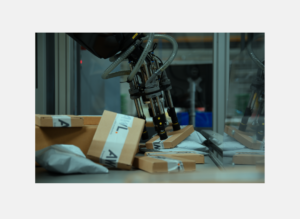Exploring the Future of Unit Sorters: Is Robotic Induction the Way Forward?
In the realm of modern logistics, the efficiency and accuracy of unit sorters are vital for ensuring seamless operations. As the industry evolves, and the labor challenge grows, there’s a trend toward investigating robotic induction systems. This innovative approach promises to revolutionize the way parcels and polybags are handled, presenting a compelling vision for the future of sorting technology. But is it ready for primetime? Let’s explore the four main requirements to consider when making the choice whether Robotic Induction makes sense for your operation.
Accuracy
- First and foremost, when inducting items there is a need for accuracy onto the sorter. This touch is typically the last confirmation of the identity of an item, and ensuring that there are not two items being picked up at the same time, or even no item at all is of utmost importance. Many robotic suppliers have implemented doubles detection or successful pick detection as a standard, while the more advanced suppliers may even have weighing on the fly or scanning on the fly capabilities to ensure accuracy. This all ensures that the induction accuracy is close to, or as high as a comparable FTE.
Throughput
- As labor becomes harder to find and attract, swapping low-skill, repetitive tasks for automation and moving Full-Time Employees (FTE) to higher skill jobs becomes more enticing. A robotic induction does not have to equal the throughput of a person because the benefits of having that FTE working elsewhere outweighs a pure labor savings Return On Investment (ROI). Labor savings certainly plays a role in the decision, however the discussion needs to be more well-rounded than that. Generally, the systems on the market today are inducting at between 600-1,400 uph compared to a well-trained operator who is generally in the 1,200-1,700 uph range. Throughput for robotic induction has been increasing for a number of years however, so it is likely that we are not too far off when robots are as efficient or even more so than a manual operator (with the correct product).
Product Range
- Humans are extremely capable at handling any item under 50 lbs., of any shape, in any size, or any material. We can do things like fold loose garments in half, face barcodes upright, or even separate two items that are stuck to each other with tape. These things all contribute to an accurate, efficient induction process. Robotic inductions do not have this flexibility yet. Many can handle lots of different item types, of differing weights, and differing materials, but some of the more intricate tasks are still far out of reach. Your individual product mix is something that needs to be closely considered when making the choice whether or not to implement robotic induction.
Price
- With the average burdened cost of an FTE approaching $50,000 USD there is certainly an incentive to look to automating the tasks that can be automated. However, robots are still cutting edge technology with a cutting edge price and, while adding AI to the software package helps these robots “learn” how to be more efficient with time and experience, it does typically come with an added licensing and/or service fee to maintain the vast amount of data required, and constant improvements. Pricing for these systems tends to be either as a robot as a service (RAS) style, or a set CAPEX expense with a licensing fee, but either way, adding robotic induction to a unit sorter can drastically increase the initial expense of the system or significant increase the operating expense. Consider whether the extra CAP-EX or OP-EX is within your individual budget constraints.
So, what’s the verdict?
As the material handling world loves to say, “It depends”. Robotic induction is already here, and here to stay. Many of EuroSort’s customers are either investigating robotic induction, trialing 1 or a many different suppliers for robotic induction or have already implemented robotic induction into their systems. These implementations have various levels of success, and the variable that seems to impact the success of a system is the product mix more so than anything else.
From a cost perspective, the ROI is not a straightforward calculation. Generally our customers that implement these systems are not doing so for a strict labor offsetting model, but instead are having issues finding the labor in the first place. After all, it doesn’t matter how much or little labor you offset if that labor just simply isnt available. Robotic inductions have the potential to reduce your dependence on temporary labor or allow your FTE’s to be utilized in less repetitive, more skilled tasks.
At the end of the day it is a case by case decision based on your operations throughput needs, labor availability, product mix, and budget constraints. Let the experts at EuroSort talk through your operation and help guide you on whether it is right for you.
Reach out to EuroSort today to see if Robotic Induction makes sense for your operation!
